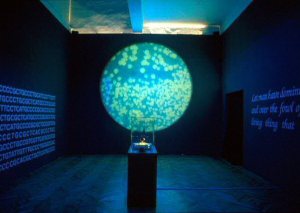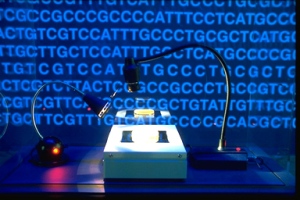‘GENESIS’
Eduardo Kac
Genesis is a transgenic artwork that explores the intricate relationship between biology, belief systems, information technology, dialogical interaction, ethics, and the Internet. The key element of the work is an “artist’s gene“, i.e., a synthetic gene that Eduardo invented and that does not exist in nature. This gene was created by translating a sentence from the biblical book of Genesis into Morse Code, and converting the Morse Code into DNA base pairs according to a conversion principle specially developed for this work. The sentence reads: “Let man have dominion over the fish of the sea, and over the fowl of the air, and over every living thing that moves upon the earth.” This sentence was chosen for its implications regarding the dubious notion of (divinely sanctioned) humanity’s supremacy over nature. Morse Code was chosen because, as first employed in radiotelegraphy, it represents the dawn of the information age — the genesis of global communications.
In the context of the work, the ability to change the sentence is a symbolic gesture: it means that we do not accept its meaning in the form we inherited it, and that new meanings emerge as we seek to change it.
“Genesis” has original DNA-synthesized music by composer Peter Gena. The music is generated live in the gallery and streamed on the Web. The parameters of this multi-channel composition are derived from bacterial multiplication and mutation algorithms.








